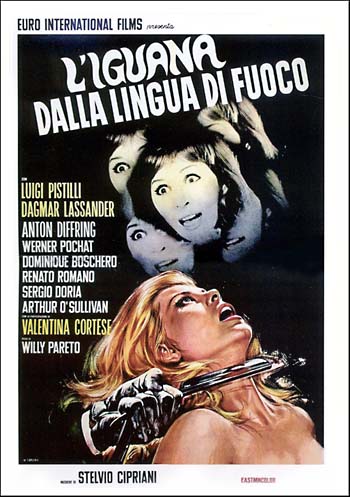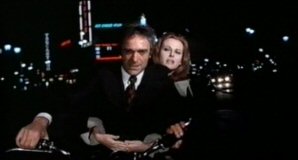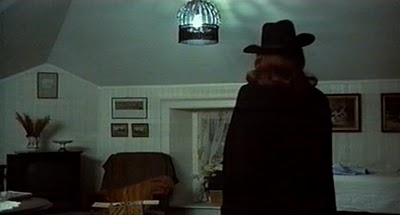
Aka L’iguana dalla lingua di fuoco
1971
Original running time: 98 minutes
Italy / West Germany
Based on the novel “A Room Without Door” by Richard Mann
An Oceaniaproduzioni Internazionali Cinem. (Rome), Les films corona (Nanterre), Terra Filmkunst (Berlin) production
Director: Willy Pareto [Riccardo Freda]
Screenplay: Sandro Continenza, Willy Pareto
Cinematography: Silvano Ippoliti
Music: Stelvio Cipriani
Editor: Willy Pareto
Cast: Luigi Pistilli (Detective John Norton), Dagmar Lassander (Helen Sobiesky), Anton Diffring (Ambassador Sobiesky), Arthur O’Sullivan (Inspector Lawrence), Werner Pochath (Marc Sobiesky), Dominique Boschero (the nightclub singer), Renato Romano (Mandel, the chauffeur), Sergio Doria (Walter, a hippy), Ruth Durley, Valentina Cortese (Ms. Sobiesky), Niall Toibin (the Doctor)
When the body of a violently murdered young woman is found in the boot of a car belonging to the Swiss Ambassador to Ireland, there’s no shortage of suspects. The Ambassador, Sobiesky (Anton Diffring), is a cold fish with an extremely complicated private life; his wife (Valentina Cortese) is a lush; his daughter (Dagmar Lassander) a promiscuous habitué of nightclubs; his stepson (Werner Pocath) a dropout whose estrangement from hi parents doesn’t prevent him from leeching cash off them at every opportunity; and even his chauffeur (Renato Romano) suffers from conjunctivitis and wears sunglasses in a suspicious fashion. As he starts his questioning, though, Inspector Lawrence (Arthur O’Sullivan) finds the case to be a political hot potato, and his task doesn’t become any easier when Sobiesky’s mistress (Dominique Boschero) turns up dead as well.

Needing to make quick progress, he calls in John Norton (Luigi Pistilli), a former detective who got chucked off the force after accidentally causing the death of a suspect. Norton, it turns out, has gone a bit haywire after his own wife’s unsolved murder, and has developed an extremely unorthodox investigative method, which mainly seems to revolve around sleeping with the suspects, breaking into people’s homes and beating random people up. Meanwhile, assorted other characters are murdered, everyone takes a quick trip to the Alps for a change of scenery and Norton’s mother has trouble finding her spectacles.
This is a pretty middling giallo effort that falls short considering the talent behind it. Although Riccardo Freda was a highly respected filmmaker, some of the direction and cinematography on display here is rather erratic, very between being lazy and hyperbolic. I remain unconvinced that Freda was quite as good a director as some people argue, especially away from the action / adventure field, where he seemed more at home than with out and out thrillers. He has talent, undoubtedly, but it’s the inclination that seems to be lacking. This is full of half-arsed zoom shots (accompanied by screeching violins on the soundtrack, natch) and so many Lewton Buses come and go that it feels like your in a Lewton Bus Station. The editing – also by Freda – is eccentric and the camera occasionally gets drawn to things that are entirely irrelevant without any kind oif explanation. Peculiarly, it’s the least relevant bits that work the best – Norton’s flashbacks, the questionning of the chauffeur – but this only goes to make it all the more unsatisfying as a whole.

Bizarrely, though, I quite enjoyed it. Apart from the amusing oirish accents, there’s some entertaining dialogue and the characters are all pretty wild. At times, it almost comes across like a sitcom with added gore – the killer has a predilection for throwing vitriol in his victims’ faces – in place of laughs. The interplay, in other words, is much better than the narrative, which is frankly all over the place. Throw in someone having some authentic looking stitches in their scalp, a distinctly dubious grasp of English geography (Ireland appears to be somewhere on the outskirts of London) and some rather dubious teenage nudity, and it all makes for an entertainingly sleazy viewing experience, no matter if it’s entirely incomprehensible and lacking in any kind of cinematographic merit.
Performance wise, my favourite character is the sinister doctor who pops up all over the place, spouting sinister dialogue and fondling scalpels in time-honoured suspicious fashion (this is actually an uncredited performance by Niall Toibin, a venerable stage performer who later had a regular part in Ballykissangel). Valentina Cortese is also good, and Pistilli gives a committed performance.
Aka L’iguana dalla lingua di fuoco
1971
Original running time: 98 minutes
Italy
Based on the novel “A Room Without Door” by Richard Mann
An Oceaniaproduzioni Internazionali Cinem. (Rome), Les films corona (Nanterre), Terra Filmkunst (Berlin) production
Director: Willy Pareto [Riccardo Freda]
Screenplay: Sandro Continenza, Willy Pareto
Cinematography: Silvano Ippoliti
Music: Stelvio Cipriani
Editor: Willy Pareto
Cast: Luigi Pistilli (Detective John Norton), Dagmar Lassander (Helen Sobiesky), Anton Diffring (Ambassador Sobiesky), Arthur O’Sullivan (Inspector Lawrence), Werner Pochath (Marc Sobiesky), Dominique Boschero (the nightclub singer), Renato Romano (Mandel, the chauffeur), Sergio Doria (Walter, a hippy), Ruth Durley, Valentina Cortese (Ms. Sobiesky), Niall Toibin (the Doctor)
When the body of a violently murdered young woman is found in the boot of a car belonging to the Swiss Ambassador to Ireland, there’s no shortage of suspects. The Ambassador, Sobiesky (Anton Diffring), is a cold fish with an extremely complicated private life; his wife (Valentina Cortese) is a lush; his daughter (Dagmar Lassander) a promiscuous habitué of nightclubs; his stepson (Werner Pocath) a dropout whose estrangement from hi parents doesn’t prevent him from leeching cash off them at every opportunity; and even his chauffeur (Renato Romano) suffers from conjunctivitis and wears sunglasses in a suspicious fashion. As he starts his questioning, though, Inspector Lawrence (Arthur O’Sullivan) finds the case to be a political hot potato, and his task doesn’t become any easier when Sobiesky’s mistress (Dominique Boschero) turns up dead as well.
Needing to make quick progress, he calls in John Norton (Luigi Pistilli), a former detective who got chucked off the force after accidentally causing the death of a suspect. Norton, it turns out, has gone a bit haywire after his own wife’s unsolved murder, and has developed an extremely unorthodox investigative method, which mainly seems to revolve around sleeping with the suspects, breaking into people’s homes and beating random people up. Meanwhile, assorted other characters are murdered, everyone takes a quick trip to the Alps for a change of scenery and Norton’s mother has trouble finding her spectacles.
This is a pretty middling giallo effort that falls short considering the talent behind it. Although Riccardo Freda was a highly respected filmmaker, some of the direction and cinematography on display here is rather erratic, very between being lazy and hyperbolic. I remain unconvinced that Freda was quite as good a director as some people argue, especially away from the action / adventure field, where he seemed more at home than with out and out thrillers. He has talent, undoubtedly, but it’s the inclination that seems to be lacking. This is full of half-arsed zoom shots (accompanied by screeching violins on the soundtrack, natch) and so many Lewton Buses come and go that it feels like your in a Lewton Bus Station. The editing is eccentric and the camera occasionally gets drawn to things that are entirely irrelevant without any kind oif explanation. Peculiarly, it’s the least relevant bits that work the best – Norton’s flashbacks, the questionning of the chauffeur – but this only goes to make it all the more unsatisfying as a whole.
Bizarrely, though, I quite enjoyed it. Apart from the amusing oirish accents, there’s some entertaining dialogue and the characters are all pretty wild. At times, it almost comes across like a sitcom with added gore – the killer has a predilection for throwing vitriol in his victims’ faces – in place of laughs. The interplay, in other words, is much better than the narrative, which is frankly all over the place. Throw in someone having some authentic looking stitches in their scalp, a distinctly dubious grasp of English geography (Ireland appears to be somewhere on the outskirts of London) and some rather dubious teenage nudity, and it all makes for an entertainingly sleazy viewing experience, no matter if it’s en
Aka L’iguana dalla lingua di fuoco
1971
Original running time: 98 minutes
Italy
Based on the novel “A Room Without Door” by Richard Mann
An Oceaniaproduzioni Internazionali Cinem. (Rome), Les films corona (Nanterre), Terra Filmkunst (Berlin) production
Director: Willy Pareto [Riccardo Freda]
Screenplay: Sandro Continenza, Willy Pareto
Cinematography: Silvano Ippoliti
Music: Stelvio Cipriani
Editor: Willy Pareto
Cast: Luigi Pistilli (Detective John Norton), Dagmar Lassander (Helen Sobiesky), Anton Diffring (Ambassador Sobiesky), Arthur O’Sullivan (Inspector Lawrence), Werner Pochath (Marc Sobiesky), Dominique Boschero (the nightclub singer), Renato Romano (Mandel, the chauffeur), Sergio Doria (Walter, a hippy), Ruth Durley, Valentina Cortese (Ms. Sobiesky), Niall Toibin (the Doctor)
When the body of a violently murdered young woman is found in the boot of a car belonging to the Swiss Ambassador to Ireland, there’s no shortage of suspects. The Ambassador, Sobiesky (Anton Diffring), is a cold fish with an extremely complicated private life; his wife (Valentina Cortese) is a lush; his daughter (Dagmar Lassander) a promiscuous habitué of nightclubs; his stepson (Werner Pocath) a dropout whose estrangement from hi parents doesn’t prevent him from leeching cash off them at every opportunity; and even his chauffeur (Renato Romano) suffers from conjunctivitis and wears sunglasses in a suspicious fashion. As he starts his questioning, though, Inspector Lawrence (Arthur O’Sullivan) finds the case to be a political hot potato, and his task doesn’t become any easier when Sobiesky’s mistress (Dominique Boschero) turns up dead as well.
Needing to make quick progress, he calls in John Norton (Luigi Pistilli), a former detective who got chucked off the force after accidentally causing the death of a suspect. Norton, it turns out, has gone a bit haywire after his own wife’s unsolved murder, and has developed an extremely unorthodox investigative method, which mainly seems to revolve around sleeping with the suspects, breaking into people’s homes and beating random people up. Meanwhile, assorted other characters are murdered, everyone takes a quick trip to the Alps for a change of scenery and Norton’s mother has trouble finding her spectacles.
This is a pretty middling giallo effort that falls short considering the talent behind it. Although Riccardo Freda was a highly respected filmmaker, some of the direction and cinematography on display here is rather erratic, very between being lazy and hyperbolic. I remain unconvinced that Freda was quite as good a director as some people argue, especially away from the action / adventure field, where he seemed more at home than with out and out thrillers. He has talent, undoubtedly, but it’s the inclination that seems to be lacking. This is full of half-arsed zoom shots (accompanied by screeching violins on the soundtrack, natch) and so many Lewton Buses come and go that it feels like your in a Lewton Bus Station. The editing is eccentric and the camera occasionally gets drawn to things that are entirely irrelevant without any kind oif explanation. Peculiarly, it’s the least relevant bits that work the best – Norton’s flashbacks, the questionning of the chauffeur – but this only goes to make it all the more unsatisfying as a whole.
Bizarrely, though, I quite enjoyed it. Apart from the amusing oirish accents, there’s some entertaining dialogue and the characters are all pretty wild. At times, it almost comes across like a sitcom with added gore – the killer has a predilection for throwing vitriol in his victims’ faces – in place of laughs. The interplay, in other words, is much better than the narrative, which is frankly all over the place. Throw in someone having some authentic looking stitches in their scalp, a distinctly dubious grasp of English geography (Ireland appears to be somewhere on the outskirts of London) and some rather dubious teenage nudity, and it all makes for an entertainingly sleazy viewing experience, no matter if it’s entirely incomprehensible and lacking in any kind of cinematographic merit.
Performance wise, my favourite character is the sinister doctor who pops up all over the place, spouting sinister dialogue and fondling scalpels in time-honoured suspicious fashion (this is actually an uncredited performance by Niall Toibin, a venerable stage performer who later had a regular part in Ballykissangel). Valentina Cortese is also good, and Pistilli gives a committed performance.
tirely incomprehensible and lacking in any kind of cinematographic merit.
Performance wise, my favourite character is the sinister doctor who pops up all over the place, spouting sinister dialogue and fondling scalpels in time-honoured suspicious fashion (this is actually an uncredited performance by Niall Toibin, a venerable stage performer who later had a regular part in Ballykissangel). Valentina Cortese is also good, and Pistilli gives a committed performance.